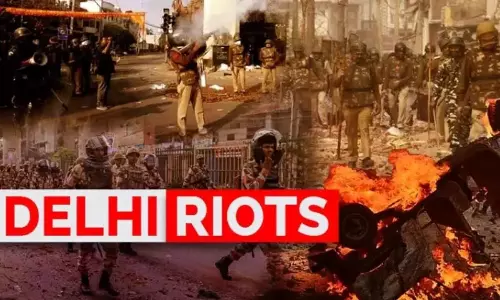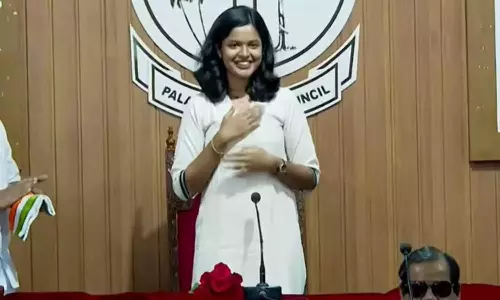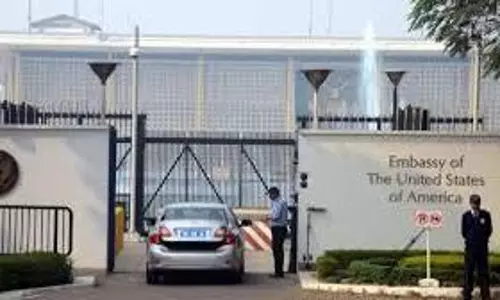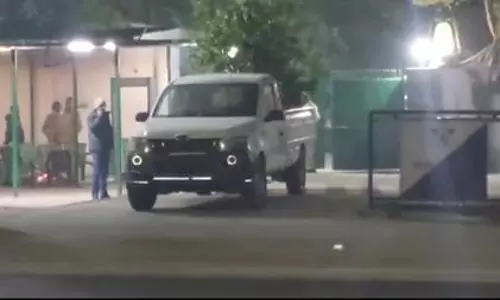

From 'Laal Salam' to 'Jai Sri Ram,'; Politics in West Bengal undergoes a metamorphosis
text_fieldsSecularism and socialism, the values which West Bengal and its people have always stood for, are biting the dust. West Bengal has always been the cradle of left-wing political movements in India, stalwarts like Subhas Chandra Bose had led the leftist traditions in Indian National Congress since before Independence. From MN Roy to Jyoti Basu, Bengali leaders have nurtured left-wing ideology and politics. As West Bengal approaches a watershed assembly poll, however, the 'Laal Salaam' slogan has yielded place to 'Jai Sri Ram;' with 'Vande Mataram' fighting for a toe-hold, courtesy Mamata Banerjee.
The decline of left-wing politics had started about a decade and a half ago when the Left Front government in its last leg forgot all about land reforms and went for land acquisition on a large scale to set up industries. At the receiving end were tillers, many of whom were people belonging to the minority communities living in the geographical area known as West Bengal today for many generations. In stepped Mamata Banerjee and her Trinamool Congress to capitalize on the discontent in the villages and upstage the Left Front. Anxious to establish her secular credentials and get rid of the baggage of the past in the shape of a stint in the BJP-led NDA, she went to the other extreme of attending religious congregations covering her head.
The exit of the Left Front not only left a political vacuum in West Bengal but also an ideological vacuum, coupled with the decline of Marxism globally at the turn of the century. Mamata Banerjee filled the political vacuum but she did not have much to offer by way of an alternative ideology; except garlanding statues of doyens of the Bengali renaissance and heroes of Independence movement and declaring their birthdays as State holidays.
Her pathological hatred of the CPI(M), a result no doubt of a murderous assault once she had survived and all the humiliations she had to put up with during the Singur agitation, resulted in attacks by Trinamool Congress youths on CPI(M) activists; and also on supporters of Congress whom Mamata Banerjee had always regarded as B-team of CPI(M). The space that is necessary for the opposition in a liberal democracy was thus denied.
The vacuum in ideology and also in the space for the opposition was an ideal opportunity for the BJP to step in, with its regimented Sangha Parivar and the Hindutva ideology. Support came quickly; particularly from a section of CPI(M) workers who were at the receiving end of the Trinamool's stick and thought BJP was the party that would be in a position to offer them shelter. The Hindutva agenda, too, worked with the feeling spreading among a section in the society that the minorities were being pampered.
Issues of caste, never of any importance in Bengal politics which was always dominated by class considerations also started gaining prominence. The trend was initiated by Mamata Banerjee herself when she started wooing the Matua community, belonging to the Namashudra caste. Coming from Bangladesh as refugees, they had settled in the border districts and are now said to be the deciding factor in more than 20 assembly seats in West Bengal. Critics say the Left Front government had never been seriously concerned about problems faced by people in the lower rungs of the social ladder as the communist movement had always been led by high-caste Hindus.
Ideologically and in terms of programmes, there is not much difference between Trinamool Congress and BJP, except the Hindutva agenda. What Trinamool can do, however BJP can do better with the vast resources of the Central government at its command. Among the Matua community, Mamata Banerjee had gone ahead with a programme of bestowing title of the land they had settled on, issuing land pattas. BJP has now come forward with the Citizenship Amendment Act, offering the refugees citizenship.
It is still an open question, however, if this will turn the Matua votes in favour of BJP as there is a question mark when the provisions of CAA would be implemented. The Act has been passed but the rules have not yet been framed. BJP, being a national party, has to take into consideration the realities in other states too. In Assam, there is a groundswell of opposition against the CAA, as it is felt that its provisions run contrary to the spirit of the Assam Accord, under which illegal immigrants must be deported irrespective of their religious identity.
CAA can also cut both ways in north Bengal, where BJP did exceptionally well in the Lok Sabha election of 2019. Many of the Bengali Hindus settled in north Bengal have their origin in East Bengal, from where they had migrated during Partition and at later dates. CAA will take care of the problem of their citizenship but the indigenous Rajbongshi community can have reservations. For, the indigenous people feel that the immigrants have occupied their land. In 2019, senior BJP leaders had been liberal in their promise to the Rajbongshi community to set up a separate Kamtapur state. Now, however, promises of both Gorkhaland and Kamtapur seem like a mirage as the first priority of BJP is to win over mainland Bengal to form the next State Government.
In the run-up to the assembly polls, leaders of BJP and Trinamool Congress are also locked in a bitter battle in districts in the western part of West Bengal dominated by tribes. Mamata Banerjee had won over the scheduled tribes from the Left Front fold by the simple device of offering rice at Rs 2 a kg at ration shops. The step had worked wonders, too, to ward off the growing Maoist influence in the districts of West Midnapore, Purulia and Bankura. In 2019, BJP turned the tables on Trinamool, winning the Jhargram, Purulia, Midnapore and Bankura Lok Sabha seats. Charges like irregular distribution of ration and corruption in the ranks of Trinamool leaders seem to have worked wonders, but the Sangh Parivar in the past few years have set up a number of Ram temples in the tribal-dominated areas. Parivar members also run many schools for tribal children in these areas.
The new-found emphasis on caste, creed and religion in the political scene of West Bengal has singed also the high priests of Marxism in West Bengal. The CPI(M)-led Left Front, besides aligning with Congress, has also entered into a seat-sharing deal with Indian Secular Front, a party of the minority community led by influential cleric of Furfura Sharif Abbas Siddique. Out of the 294 seats in the West Bengal, the Congress – Left Front alliance has left 37 seats to ISF. Congress would contest in 92 seats and the Left Front in 165. This alliance may help CPI(M) win some of its lost minority votes but if the ISF succeeds in making a dent in the minority support base of Trinamool Congress, the ultimate gainer may be the BJP.






















